Integrated Farm Planning
According to Allan Rosenburg and Thomas Landers, integrated farm planning, can be defined as: “To determine the existing and\or available resources on the farm, which resources will still be needed to maintain future goals and also to have an unmistakable objective of where you are aiming to?”
Click here to view a video that explains integrated farm planning.
Integrated farm planning: Integrated farm planning (whole farm planning) thus, is a tool for developing a sustainable farming system.
Sustainable agriculture: Sustainable agriculture can be seen as a philosophy as well as a farming system as it has its roots in a set of values that reflects a state of awareness of ecological and social realities and one’s ability to take preventative action. It also involves the design and management processes that work with natural processes to conserve all resources, minimize waste and environmental impact while maintaining or improving productivity.
Farm Layout: A Farm layout refers to the compiling of physical structures such as homesteads, outbuildings, waterways, contours, camps, water supply roads and the layout of orchards, vineyards or lands. However, the area where the farm is situated, the topography, the availability of natural resources, the farming practices, the different enterprises, the availability of capital and the preference of the farmer/owner will also affect the farm layout.
Principles of Integrated Farm Planning
- Whole farm planning is a process that assists farmers to analyse the farming operation.
- Each production system must be planned and combined with the other systems.
- Both the physical infrastructure and the economical and management inputs must be planed.
- Accurate information needs to be obtained to ensure proper planning.
What role does Integrated Farm planning play in the success of a farming business? Integrated farm planning is one of the components that will contribute to the success of the farming business. There must be proper planning of the production system, marketing, quality of products and financial planning.

Steps Involved in Whole Farm or Integrated Farm Planning
The following steps are involved in whole farm planning
- Setting of goals
- Making an inventory and assessment of existing farm resources 3. Developing and implementing an action plan
- Monitoring on-farm processes towards the goal
Step 1: Setting of goals
Whole farm planning begins with the development of a long-term goal or vision for the farming business.
The farmer needs to determine the following:
- The quality of life expectancy for his family and himself
- What is his vision or aim for the future of the farming business?
- The amount of income needed from the farming business to ensure an atmosphere in which his family, his workers and their families may live a sensible life.
- The farming business needs to determine long term goals e.g. the reduction of debt, the improvement of soil fertility, etc. Short term goals e.g. the planning of tillage methods, diversification of crops or enterprises and improving the marketing of products.
- Human and social resources include the manpower available, the skills level and the training of the different farmworkers.
- Environmental resources
- Economic and financial resources
Step 2: Inventory and Assessment
These goals should relate to the following resource areas to be able to properly plan and inventory resources which include natural resources, human resources and financial resources.
- Natural resources can be determined by using a farm map, soil maps, soil testing, and availability of water, veld types and vegetation. It can be obtained through the study of the maps and other documentation or by conducting a natural resource audit where the person collects the necessary data from the source.
- Human resources include manpower availability, the skills level and training of the different farmworkers.
- The financial assets or resources are the capital available or the collateral the farmer has to secure a loan from financial institutions.
With this step in the planning process the farmer determined (stock take) which sources are available, how these can be used and the means of getting to the goals.
Step 3: Action Plan
The planning that was done in the previous steps needs to be put into action. The management alternatives need to be identified and evaluated and then be used to develop an action plan.
The action plan must fit in with the goals set in the first step and must make use of all existing positive resources as it can influence future planning.
Step 4: Monitoring and Control
Management alternatives must be evaluated separately to determine which plan suits the farming business best. As the whole farm plan is implemented, you need to evaluate the different options and plans to determine if it works. It might be necessary to make minor adjustments to the plan as time goes on. Keep accurate records and evaluate to see if the farming business is still on the right track and achieving the goals set out.

The Role that Integrated Farm Planning Play Regarding The Conservation Of Natural Resources

Whole farm planning assesses the physical aspects of the farm with regards to soil, vegetation and topography. This physical stocktaking of the farm is then the basis of farm design and layout.
This may include soil conservation structures, water supply, irrigation and the improvement of natural vegetation or the eradication of alien plants.
- The implications of integrated farm planning.
- The implications of whole farm planning enable the farmer or the manager to consider the natural resources and take all the internal and external factors into account when decisions are made concerning the production systems, type of products produced and the marketing of the products
- The importance of integrated farm layout.
- The focus of integrated farm planning is to consider the entire production of possible agricultural products and to plan the farm infrastructure in such a way that it complements the production process; it also ensures the sustainable use of natural resources.
- The main considerations when doing Integrated Farm Layout.
- The main consideration of whole farm planning is to ensure sustainability and balanced management of the whole property in the long term and to encourage the farmer or manager to develop risk management and drought management strategies as a means of increasing his self-confidence and viability.